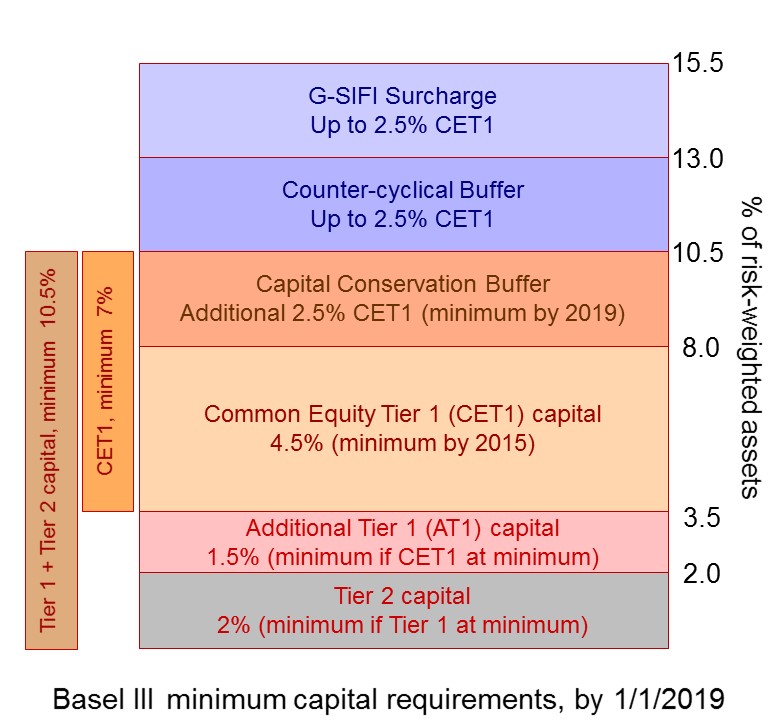 Under the auspices of the Bank for International Settlements (BIS), banks around the world are working their way towards implementing tougher capital requirements. These tougher rules, known as ‘Basel III’, are due to come fully into operation by 2019.
Under the auspices of the Bank for International Settlements (BIS), banks around the world are working their way towards implementing tougher capital requirements. These tougher rules, known as ‘Basel III’, are due to come fully into operation by 2019.
This third version of international banking rules was agreed after the financial crisis of 2008, when many banks were so undercapitalised that they could not withstand the dramatic decline in the value of many of their assets and a withdrawal of funds.
Basel III requires banks to have much more capital, especially common equity capital. The point about equity (shares) is that it’s a liability that does not have to be repaid. If people hold bank shares, the bank does not have to repay them and does not even have to pay any dividends. In other words, the money raised by issuing shares carries no obligation on the part of the bank and can thus provide a buffer against large-scale withdrawal of funds.
Under Basel III, banks have to maintain sufficiently large ‘capital-adequacy ratios’. As Essentials of Economics (7th edition) explains:
Capital adequacy is a measure of a bank’s capital relative to its assets, where the assets are weighted according to the degree of risk. The more risky the assets, the greater the amount of capital that will be required.
A measure of capital adequacy is given by the capital adequacy ratio (CAR). This is given by the following formula:
Common Equity Tier 1 (CET1) capital includes bank reserves (from retained profits) and ordinary share capital (equities), where dividends to shareholders vary with the amount of profit the bank makes… Additional Tier 1 (AT1) capital consists largely of preference shares. These pay a fixed dividend (like company bonds), but although preference shareholders have a prior claim over ordinary shareholders on the company’s (i.e. the bank’s) profits, dividends need not be paid in times of loss.
Tier 2 capital is subordinated debt with a maturity greater than 5 years. Subordinated debt holders only have a claim on a company (a bank) after the claims of all other bondholders have been met.
Risk-weighted assets are the total value of assets, where each type of asset is multiplied by a risk factor. Under the Basel III accord, cash and government bonds have a risk factor of zero and are thus not included. Interbank lending between the major banks has a risk factor of 0.2 and is thus included at only 20 per cent of its value; residential mortgages under 60% of the value of the property have a risk factor of 0.35; personal loans, credit-card debt and overdrafts have a risk factor of 1; loans to companies carry a risk factor of 0.2, 0.5, 1 or 1.5, depending on the credit rating of the company. Thus the greater the average risk factor of a bank’s assets, the greater will be the value of its risk weighted assets, and the lower will be its CAR.
 Basel III gives minimum capital requirements that are higher than under its predecessor, Basel II. Thus, by 2019, banks must have a common equity capital to risk-weighted assets of at least 4.5% and a Tier 1 ratio of at least 6.0%. The overall CAR should be at least 8%. In addition, the phased introduction of a ‘capital conservation buffer’ from 2016 will raise the overall CAR to at least 10.5 per cent.
Basel III gives minimum capital requirements that are higher than under its predecessor, Basel II. Thus, by 2019, banks must have a common equity capital to risk-weighted assets of at least 4.5% and a Tier 1 ratio of at least 6.0%. The overall CAR should be at least 8%. In addition, the phased introduction of a ‘capital conservation buffer’ from 2016 will raise the overall CAR to at least 10.5 per cent.
Over the past few years, banks have increased their capital cushions significantly and many have exceeded the Basel III requirements, even for 2019.
But the Basel Committee has been reconsidering the calculation of risk-weighted assets. Because of the complexity of banks’ asset structures, which tend to vary significantly from country to country, it is difficult to ensure that banks’ are meeting the Basel III requirements. Under proposed amendments to Basel III (which some commentators have dubbed ‘Basel IV’), banks would have to compare their own calculations with a ‘standardised’ model. Their own calculations of risk-based assets would then not be allowed to be lower than 60–90% (known as ‘the output floor’) of the standardised approach.
While, on the surface, this may seem reasonable, European banks have claimed that this would penalise them, as some of their assets are less risky than the equivalent assets in other countries. For example, Germany has argued that mortgage defaults have been rare and thus German mortgage debt should be given a lower weighting than US mortgage debt, where defaults have been more common. If all assets were assessed according to the output floor, several banks, especially in Europe, would be judged to be undercapitalised. As The Economist article states:
Analysts at Morgan Stanley estimate that global, non-American banks could see risk-weighted assets rise by an average of 18–30%, depending on the level of the output floor. Extra capital of €250bn–410bn could be needed, a tall order when earnings are thin and investors wary. The committee’s reviews of operational and market risks would add even more.
This question of an output floor was a sticking point at the Basel Committee meeting in Santiago, which ended on 30 November. Although some progress was made about agreeing to rules on risk weighting that could be applied globally, a final agreement will have to wait until the next meeting, in January – at the earliest.
Articles
Basel bust-up: A showdown looms over bank-capital rules The Economist (26/11/16)
Bank regulators fail to agree on new rules Manila Standard (2/12/16)
Bank chief Claudio Borio urges regulators to ‘stay strong’ Weekend Australian, Michael Bennet (29/11/16)
Final Basel III rules meet resistance from Europe The Straits Times (2/12/16)
This Is the Absolutely Worst Time to Weaken Global Bank Rules American Banker, Mayra Rodriguez Valladares (2/12/16)
New Basel banking rules’ impact on European economy Financial Times, Frédéric Oudéa (28/12/16)
Banks like RBS still look risky, but getting too tough could cause greater problems The Conversation, Alan Shipman (1/12/16)
BIS publications
International banking supervisory community meets to discuss the regulatory framework BIS Press Release (1/12/16)
Basel III: international regulatory framework for banks Bank for International Settlements
Basel III phase-in arrangements Basel Committee on Banking Supervision, BIS
Basel Committee on Banking Supervision reforms – Basel III, Summary Table Basel Committee on Banking Supervision, BIS
Questions
- Why do reserves in banks have a zero weighting in terms of risk-based assets?
- What items have a 100% weighting? Explain why.
- Examine the table, Basel III phase-in arrangements, and explain each of the terms.
- If banks are forced to operate with a higher capital adequacy ratio, what is this likely to do to bank lending? Explain. How are funding costs relevant to your answer?
- Explain each of the items in the Basel III capital-adequacy requirements shown in the chart above.
- What is the American case for imposing an output floor?
- What is the European banks’ case for using their own risk weighting?
- Why is it proposed that larger ‘systemically important banks’ (SIBs) should have an additional capital requirement?
- How does the balance of assets of American banks differ from that of European banks?
